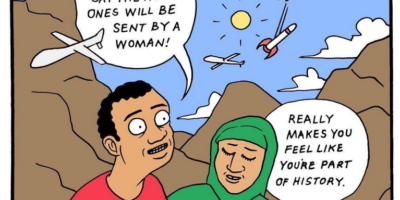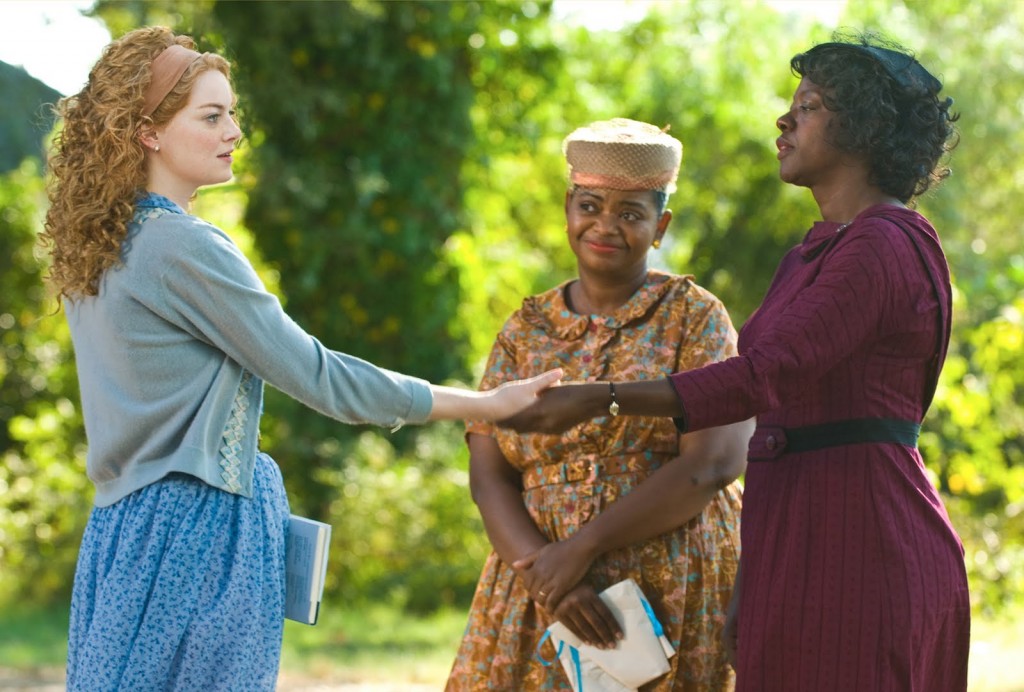By Christian L. Pyle
Tate Taylor’s recent movie, The Help, garnered substantial box office and a majority of positive reviews (73% fresh on RottenTomatoes.com), but some critics denounced it. Tulane University professor Melissa Harris-Perry called it “ahistorical and deeply troubling.” Dana Stevens of Slate.com wrote that The Help put “a Barbie Band-Aid on the still-raw wound of race relations in America.”
The Help attempts to cover the mistreatment of African-American maids by their white employers in Jackson, Mississippi in 1963, the year of Martin Luther King’s march on Washington and Medgar Evers’ assassination. At the center of the film is “Skeeter” Phelan (Emma Stone), an aspiring writer and editor of the newsletter of the Junior League, an organization of former debutantes headed by the film’s villain, Hilly Holbrook (Bryce Dallas Howard). The only writing job Skeeter can find in Jackson is ghosting a housework advice column in the newspaper. Having been brought up with (and by) a maid, Skeeter has no clue how to perform housework, so she enlists the aid of Aibileen Clark (Viola Davis), the maid for another Junior Leaguer.
As Skeeter begins to explore the life of a maid, she finds that a bizarre and paranoid set of restrictions keeps the maids from using the bathrooms in the houses they clean and confines them to using the same plate and glass every day for their meals. Blacks carry different diseases than whites, explains Hilly, who is spearheading a campaign to put special bathrooms in white houses for the help to use. Hilly fires her own maid, Minny Jackson (Octavia Spencer), after Minny uses the indoor bathroom during a storm.
Skeeter is a familiar type of heroine—too smart and forward-thinking for her environment and brave enough to let everyone know it. Skeeter decides that the treatment of maids must be brought to light. After getting a contract with Harper & Row, Skeeter secretly begins to gather the stories of maids, beginning with Aibileen and Minny, then expanding to others. Skeeter realizes that what she’s doing is illegal (Mississippi had a law against promoting racial equality), and the maids are aware of the terrible violence they would face if their participation became known. Skeeter’s book, The Help, disguises the names of both the innocent and the guilty but creates a local scandal nonetheless.
Racial innocence
Hollywood’s approach to the subject of racism is often to promote fantasies of “racial innocence” for white viewers. The phrase comes from Shelby Steele’s oft-anthologized essay “The Recoloring of Campus Life.” While researching race relations on college campuses, African-American prof Steele found that white students would begin protesting their “racial innocence”—saying, for example, “some of my best friends are black”—even before Steele brought up the topic of race. He felt that the white students saw his skin color as an accusation of racism against which they hurried to defend themselves.
In the racial innocence genre of films, the white protagonist stands outside the racism in society, allowing white viewers to absolve themselves of the historical crimes being portrayed. In The Help, Skeeter brings the audience with her as she rebels against her social class and leads a literary revolt.
From the very beginning, Skeeter stands apart from the superficial concerns of peers like Hilly, so the audience is never forced to identify with the racist culture of Jackson in 1963. Minority characters tend to be secondary in such a movie, despite the fact that the film is ostensibly “about” them.
In The Help, Aibileen and Minny get a generous amount of screen time, and Viola Davis performs voice-overs throughout the movie. Yet Skeeter is the vehicle of whatever liberation is provided in this depiction of the civil rights era. Some African-American viewers have been troubled by this, as Skeeter seems to occupy the position of leaders such as King and Evers (and the countless real-life Aibileens and Minnies who bravely marched with them). In The Help, racial justice is not something black people won but something a white person gave.
Racism itself is dumbed down to its most extreme elements in a racial innocence film to provide the starkest contrast with the audience’s own beliefs. Usually this extreme is violent, but Taylor’s female centered film offers us obsessive snob Hilly instead of torch-wielding Klansmen. Most of the comedic moments have Hilly embarrassed and humiliated to the viewers’ delight. Skeeter schemes to have toilets dumped on Hilly’s perfect lawn. Minny gets revenge for being fired by serving up a feces- filled pie to Hilly. Racism, we see, is the exclusive property of the stupid and the mean; it could never taint the minds of the rest of us.
As a movie, The Help is a mess. The tone jumps wildly from comedy to tragedy without the skill needed to make the transition smoothly. Buried within are the seeds of a better movie that focuses exclusively on Aibileen, who could serve well for a serious movie on this subject matter.
Two dances with whitey
However, the racial innocence formula is not limited to bad movies. Consider Kevin Costner’s 1990 epic western Dances with Wolves. It’s a perfect example of the racial innocence paradigm as the genocide of Native Americans is reduced almost to a backdrop for the transformation of Army Lt. John Dunbar (Costner) into Dances with Wolves, a Lakota Sioux warrior. Mr. Wolves even finds love in the tribe thanks to the medicine man’s adopted white daughter Stands with a Fist (Mary McDonnell). By the time more US Army troops arrive, the film’s white hero has been fully integrated with the Lakota, safe from any association with the slobbering, barbaric racists who come to carry out a mission of murder and subjugation. White America responded enthusiastically to Dances with Wolves, granting the film Oscars for Best Picture and Best Director. (Today, the spell having worn off, most film lovers would snatch those golden statues out of Costner’s hands and give them to Martin Scorsese for Goodfellas.)
The same year, 1990, saw the release of my favorite film about racism, Sidney Lumet’s Q&A. The fact that Q&A is about racism may have eluded many viewers as it is ostensibly a brutal crime drama about an idealistic investigator pursuing a corrupt cop. Brand-new ADA Aloysius Francis “Al” Reilly (Timothy Hutton) is assigned to investigate the shooting of a Hispanic gangster by legendary NY cop Mike Brennan (Nick Nolte, sporting bright-red hair and a thick red mustache). Al’s boss, Kevin Quinn (Patrick O’Neal), assures Al that the shooting is a simple case of self-defense. Al works with two cops, Luis Valentin (Luis Guzman) and Sam “Chappy” Chapman (Charles S. Dutton). Their investigation brings Al face-to-face with an old love, Nancy Bosch (Jenny Lumet, the director’s biracial daughter), who witnessed the shooting with her current boyfriend, Puerto Rican drug dealer Roberto “Bobby Tex” Texador (Armand Assante).
Two years earlier, Nancy had dumped Al, then a cop, because of the look on his face when he met her African-American father for the first time. To her, Al’s pale-faced shock showed racism lurking in his heart. Encountering Nancy again causes Al to explore his own feelings and to ask other characters whether they also see the racism in him. For example, he asks Chappy, who’s black, how he spots racists who hide their bias. Chappy responds, “Well, you see, they ask a lot of dumb questions about what it’s like being a black policeman.”
Al is neither stupid nor mean, and he desperately wants to be free of racial bias. However, as the product of a racist culture, he cannot escape its programming. In the same year that Kevin Costner is offering white viewers honorary membership in a minority group slaughtered by whites, Sidney Lumet drills into the true nature of racism.
The world of Q&A offers racial innocence to no one of any shade. Bias and tribalism are in the air the characters breathe. The characters are hyper-conscious of everyone’s racial or ethnic heritage. Lumet’s screenplay is a tapestry of racial, ethnic, sexist, and homophobic slurs.
Only two major characters avoid using such language. One of them is Al, who speaks very cautiously. The other is Quinn, who is about to embark on a political career that he expects will land him in the governor’s mansion. Like any politician, Quinn veils his racism. In the first meeting between Al and Quinn, Quinn comments on Al’s time as a cop, “I see you served in Harlem, also. It’s bad there.” Al responds, “Yes, sir, it is. Those people have a tough time.” Quinn growls, “[If] you want to serve as the house liberal, I can transfer you back to Mr. Bloomenfeld’s office.”
Not that all racism is created equal. One point on which Dances with Wolves and Q&A agree is that the extremes of racism are evil and violent. The extreme in Q&A is represented by Brennan, a hulking figure of barely contained rage. (Nolte gained 40 lbs for the role.) His idea of a compliment is to call Chappy “the whitest black man I ever knew.” Brennan reminds Al several times that Al’s father was a cop with the same brutal reputation. Of the late Reilly Sr., Brennan says, “He knew there was animals out there! He knew there was a line that the niggers, the spics, the junkies, the faggots had to cross to get into people’s throats. He was that line. I am that line!” However, defeating Brennan gives no one, least of all Al, any reassurance that this dark world has brightened with the ogre gone. In the film’s final scene, Al is still trying to come to terms with his own cultural programming.
The flight to racial innocence is easy…and popular. Dances with Wolves was a critical and commercial success while Q&A flopped at the box office despite some good reviews. Q&A is out of print on DVD; Dances with Wolves was re-released in January in a 20th-anniversary edition on DVD and Blu- Ray.
Sidney Lumet told us the truth: America’s racial past and present are encoded in our culture, our myths, and our identities. Cleansing our programming of bias takes work, and feel-good Hollywood lies only detract from that.




Leave a Reply